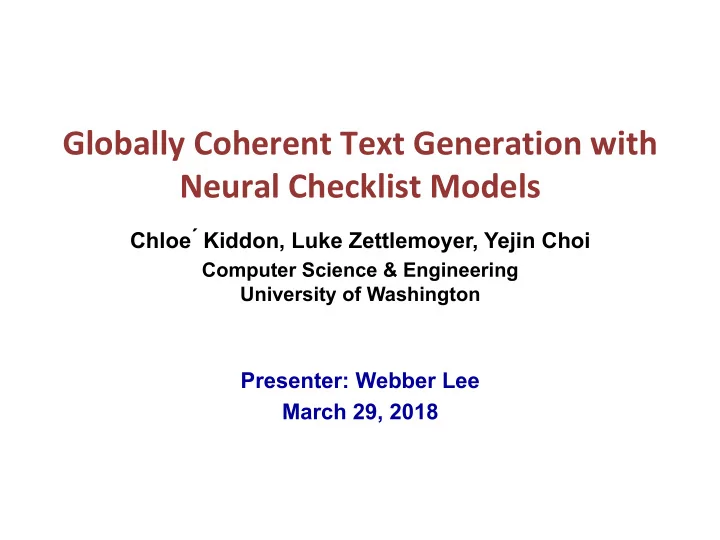

Globally Coherent Text Generation with Neural Checklist Models � Chloe ́ Kiddon, Luke Zettlemoyer, Yejin Choi Computer Science & Engineering University of Washington � Presenter: Webber Lee March 29, 2018 �
Outline � • Introduction • Previous work • Task description • Proposed model • Experimental results • Conclusion
Introduction � • Recurrent neural network (RNN) has been proven to be well suited for many natural language generation tasks • Problems: – Can miss information – Can introduce duplicated or superfluous content – Common when • There are multiple distinct sources of input • Length of output text is long • Example: generating a cooking recipe – Input: title and ingredient list – Output: complete text that describes how to produce desired dish – Problem: may lose track of which ingredients have already been mentioned
Previous work � • Attention models have been used for many NLP tasks – used to record what has been said and to select new agenda items • Previous works focus on generating short texts and assume fixed set of agenda items – Composes longer texts with a more varied and open ended set of agenda items • Other challenges: – Maintain coherence – Avoid duplication – … �
Task description � • Input: – A goal g • ex1: Recipe generation; recipe title; “pico de gallo” • ex2: Dialogue system; dialogue type; “inform” or “query” – An agenda E = {e 1 , e 2 , … , e |E| } • ex1: ingredient list; “lime,” “salt” • ex2: hotel name, address, or details • Output: – A goal-oriented text x • ex1: Mix the turkey with flour, salt … • ex2: Hotel Stratford does not have internet
Neural checklist model � • Goal: generate a recipe for a particular dish while keeping track of an agenda of items (list of gradients) to be mentioned • The model learns interpolate among three components at each time step: – An encoder-decoder language model to generate goal-oriented texts – An attention model that tracks remaining agenda items to be introduced – An attention model that tracks used or checked agenda items
Example checklist recipe generation �
Definitions of proposed model � Given � • Goal embedding: • Matrix of L agenda items: • Checklist of what items have been used: • Previous hidden state: • Current input word embedding: Computes � • Next hidden state: • Embedding used to generate output word: • Updated checklist:
Diagram of neural checklist model � a t � a t-1 � Update checklist � New agenda item reference model � o t � h t � Generate GRU language output � model � Used agenda item reference model � f t � 3-way g � classifier � h t-1 � x t � E t � h t �
Diagram of neural checklist model �
Generating output token probabilities � • Project output hidden state O t into vocabulary space – W o is a trained projection matrix
Generating output token probabilities � • Output hidden state is the linear interpolation of – c t gru : content from Gated Recurrent Unit (GRU) – c t new : encoding from new agenda item reference model – c t used : encoding from previously used item model – f t = [ f t gru , f t new , f t used ] is interpolation weights learned by a three- way probabilistic classifier �
New and used agenda item reference models � • Key features: – predicts which agenda item is being referred to – stores those predictions for use during generation • Checklist vector a t represents the probability each agenda item has been introduced into the text – initialized to all zero at t = 1 • Renaming/used item matrices – replicate L-dimensional vector by k times (i.e., R L à R L x k ) – element-wise multiplication
Agenda item reference models (cont) � • The alignment is probability distribution representing how close h t is to each item • The attention encoding is the attention-weighted sum of agenda items
Agenda item reference models (cont) � • Checklist update
Review of GRU model �
Modified GRU model �
Experimental Setup � • Implemented and trained using Torch framework • Two tasks: (1) recipe generation (2) dialogue responses • Parameters – gradient norm: 0.5; uniformly on [-0.35, 0.35] – beam search size: 10 – learning rate: 0.1 – temperature hyper-parameters (beta, gamma) • recipe: (5,2) • dialogue: (1, 10) – hidden state size • recipe: 256; dialogue: 80 – batch size • recipe 30; dialogue: 10
Quantitative results on recipe task � • You’re Cooking recipe library – 82,590 recipes used for training; 1000 for development and testing • BLEU and METEOR are not good metrics for this task �
Human evaluation results on recipe � • Syntax: grammaticality • Ingredient use: how well recipe adheres to ingredient list • Follows goal: how well recipe accomplishes desired dish • Surprisingly, Attention, EncDec and Checklist beat Truth in terms of grammar due to – noise in parsing the true recipes – neural models tend to generate shorter simpler texts �
Example qualitative analysis �
Conclusion � • RNNs (esp. GRU and LSTM) are well suited for natural language generation tasks • Baseline RNN guarantees local coherence, while integration of agenda items (attention) guarantees global coverage • Commonly used metrics (such as BLEU and METEOR) may not be a good measurement – Typically, human evaluation will be needed
Thank you! �
Recommend
More recommend